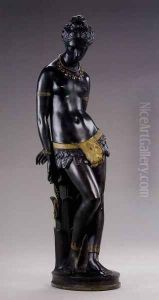Jean-Baptiste-Joseph De Bay Paintings
Jean-Baptiste-Joseph De Bay, also known as De Bay père to distinguish him from his son, was a French sculptor whose career spanned the late 18th and the majority of the 19th century. Born on May 27, 1779, in Lille, France, De Bay was part of a period of significant change in art and society, experiencing the aftermath of the French Revolution, the Napoleonic era, and the rise of Romanticism.
De Bay received his early artistic training at the École des Beaux-Arts in Paris, which was the premier art institution in France and played a critical role in shaping French art during that period. He was a student of the influential sculptor Jacques-Louis David, who was not only a painter but also had a significant impact on the neoclassical movement in sculpture.
Throughout his career, De Bay produced a variety of works, including statues, busts, and relief sculptures. His style was characterized by the neoclassical ideals of harmony, simplicity, and proportion, which were in vogue at the time. He often took inspiration from ancient Greek and Roman art, as well as from Renaissance masters. De Bay's works are noted for their technical skill and attention to detail, which resonated with the aesthetic standards of his era.
One of his notable works is the statue of Pharamond, which he completed in 1842 and is located at the Versailles Palace. This work is part of a series of statues depicting French monarchs, showcasing De Bay's ability to capture historical figures with dignity and grandeur. He was also responsible for various religious sculptures and was commissioned to create works for churches and other religious institutions.
De Bay's influence extended beyond his own creations, as he was part of a lineage of artists. His son, Jean-Baptiste-Joseph De Bay Jr., known as De Bay fils, was also a sculptor, and they sometimes collaborated on projects.
After a long and productive career, Jean-Baptiste-Joseph De Bay passed away on January 7, 1863. Though not as widely remembered today as some of his contemporaries, De Bay's contributions to French sculpture and his adherence to the neoclassical style have ensured him a place in the annals of 19th-century art history. His works remain a testament to the skills and artistic values of that time, and they continue to be studied and appreciated for their historical significance and craftsmanship.
